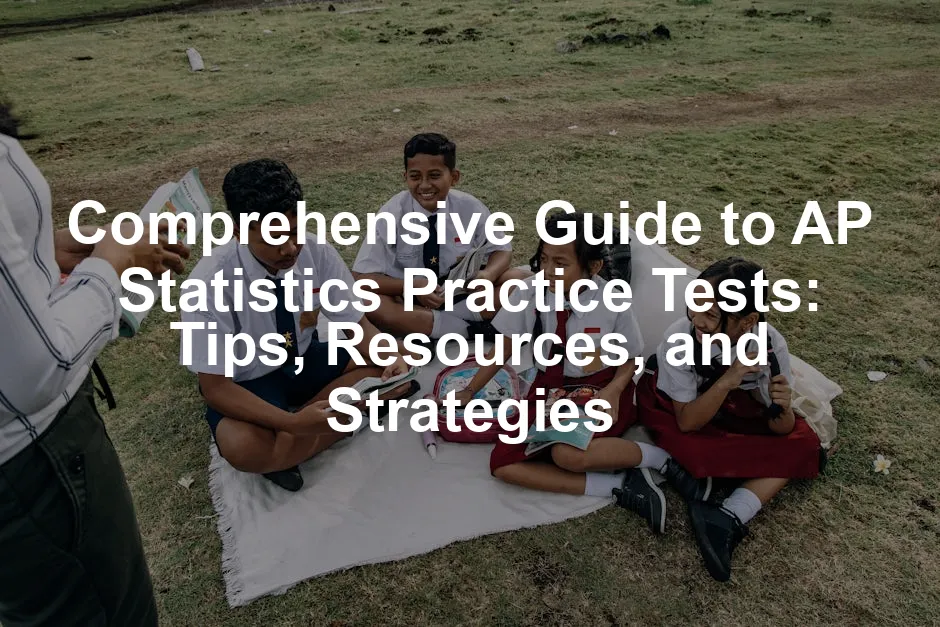Introduction
The Advanced Placement (AP) Statistics exam can send shivers down any student’s spine. It’s like facing a math monster that hides behind a curtain of probability and data analysis. But fear not! Practicing is your best weapon. It’s crucial to get your hands on practice tests to tackle the exam with confidence.
The AP Statistics exam consists of two parts: the multiple-choice section and the free-response section. The multiple-choice section has 40 questions, while the free-response section includes five traditional questions and one investigative task. Think of it as a duel where you need to be sharp on both fronts.
So why practice tests? They’re your chance to identify weak spots and improve your score before the real showdown. After all, even superheroes train before the big fight! Practice tests help you familiarize yourself with the exam format and timing. You get to understand what types of questions might sneak up on you and how to approach them effectively.
For a comprehensive study approach, consider picking up the Barron’s AP Statistics Study Guide. This guide is filled with practice questions, detailed explanations, and strategies that can help you conquer the exam. Remember, it’s not just about knowing the answers; it’s about knowing how to approach the questions!
In this guide, we’ll cover various types of practice tests, effective study strategies, and resources available to you. From official practice exams to helpful websites, we’ve got you covered. This comprehensive roadmap will lead you from confusion to clarity, making your AP Statistics journey less daunting and a lot more fun. Ready? Let’s get started!

Understanding the AP Statistics Exam Format
Overview of the Exam Structure
When you step into the AP Statistics exam room, brace yourself for a three-hour adventure divided into two main sections. The first section is the Multiple-Choice segment, featuring 40 questions to be completed in 90 minutes. Each question offers five possible answers, and your mission is to select the most accurate one.
Next, we move to the Free-Response section, which also has a 90-minute time limit. This section comprises five traditional questions and one investigative task. Get ready to flex your analytical muscles! This part requires you to write out your reasoning and solutions in detail, showing off your understanding of statistical concepts.
Both sections are equally important, contributing 50% to your overall score. So, think of them as two sides of the same coin—both are essential for your success. Each question on the AP Statistics exam tests your grasp of key concepts, data analysis, and the ability to interpret statistical results.
Understanding this structure is vital for your exam strategy. By knowing the layout, you can manage your time effectively. You’ll be less likely to panic when you see the clock ticking down, and instead, you can focus on showcasing your skills.
So, keep your eye on the prize as we explore more about the scoring breakdown and how to prepare effectively for each section. Remember, knowledge is power, and in this case, it’s your power to conquer the AP Statistics exam!

Scoring Breakdown
Understanding how the AP Statistics exam is scored is crucial for your preparation. The exam consists of two sections: multiple-choice and free-response. Each section contributes equally to your overall score, accounting for 50% each.
In the multiple-choice section, you will face 40 questions. You earn one point for each correct answer, but incorrect answers do not incur penalties. This means every correct answer boosts your score, while unanswered questions simply don’t count against you. The College Board employs a scaling process for the final score, which means your performance is compared against a predetermined standard.
The free-response section contains six questions: five traditional and one investigative task. Each question is scored on a scale of 0 to 4 based on clarity, reasoning, and correctness. Your scores from this section are summed up and converted to a standardized score that contributes equally to your final score.
Familiarizing yourself with the scoring guidelines can help you strategize your exam approach. Focusing on both sections is key to maximizing your overall score.
To further enhance your preparation, consider using Kaplan AP Statistics 2024. This resource provides an extensive review of all the key topics and offers practice questions that mimic the exam format. It’s a wise investment for anyone looking to score big!

Types of AP Statistics Practice Tests Available
Official Practice Tests
When it comes to preparing for the AP Statistics exam, nothing beats the official practice tests provided by the College Board. These resources are golden! Among the most notable are the 1997 and 2012 released exams. Why are they so special? They closely mirror the actual exam format and content.
The 1997 exam, despite its age, is still relevant. The core concepts tested have remained consistent over the years. Meanwhile, the 2012 exam reflects more recent developments in the AP Statistics curriculum. Both exams come with answer keys and scoring guidelines, making them invaluable tools for your prep.
Using official resources allows you to gauge your understanding accurately. You’ll find that the types of questions, the structure, and even the timing of these exams are strikingly similar to what you’ll encounter on test day. This familiarity can help ease anxiety and boost confidence.

Unofficial Practice Tests
While official tests are fantastic, don’t overlook the wealth of high-quality unofficial practice tests available online. Websites like Stat Trek and Varsity Tutors offer robust practice options. These unofficial exams can complement your study regimen nicely, providing a broader range of questions and scenarios.
For example, Stat Trek features a complete 40-question multiple-choice practice test. It allows you to choose between timed and untimed modes, providing immediate feedback on your answers. This instant feedback helps you identify areas that need improvement, sharpening your skills as you go.
Varsity Tutors also offers an array of practice tests and quizzes, organized by topic. This means you can target specific areas where you feel less confident. Their quizzes range from diagnostic tests to short practice sets, giving you the flexibility to study effectively.
Incorporating both official and unofficial tests into your study plan can significantly enhance your preparation for the AP Statistics exam. This strategy helps familiarize you with the exam’s format, improves your question-answering speed, and ultimately boosts your confidence when it comes time to take the test. So, grab those practice tests and get to work!

Free Response Questions
Free-response questions are a crucial part of the AP Statistics exam. They require students to demonstrate their understanding of statistical concepts in a detailed manner. Unlike multiple-choice questions, which offer a selection of answers, free-response questions demand a written explanation of your thought process. Think of them as the essay section of a math exam—juicy and full of opportunity to show off your knowledge!
The free-response section includes five traditional questions and one investigative task. Each question tests different statistical skills, like data analysis, hypothesis testing, and interpretation of results. This section makes up 50% of your overall score, so mastering it is essential.
Why are these questions so important? They allow you to express your reasoning and present your calculations. This is your chance to shine! Scorers look for clarity, accuracy, and the ability to convey complex ideas simply. You want to be the superstar who makes statistical concepts sound like a walk in the park.
To prepare effectively, you can access past free-response questions and scoring guidelines from the College Board’s website. This treasure trove of resources offers sample responses and scoring distributions, giving you insight into what high-scoring answers look like. Familiarizing yourself with these materials can help you understand what examiners expect and how to structure your answers. Check out this link for a comprehensive collection of past questions and guidelines.
Equipped with this knowledge, you’re now ready to tackle those free-response questions with confidence! Happy studying!
Reviewing Mistakes
Mistakes are part of learning, especially in AP Statistics. Analyze your practice test errors to pinpoint weak areas. Start by categorizing mistakes into types: conceptual misunderstandings, calculation errors, or misinterpretations of questions. This will help you understand where to focus your efforts.
Once you identify the problem areas, implement targeted strategies. For conceptual misunderstandings, revisit the relevant chapters in your textbook or study guides. Use online resources like Khan Academy for quick refreshers. They break down complex topics into digestible chunks, making them easier to understand.
Calculation errors? Practice, practice, practice! Work through similar problems until you feel confident. Online platforms like UWorld offer question banks that allow you to filter by topic. This targeted practice will reinforce your skills.
Don’t hesitate to seek help! Form a study group with classmates. Discussing concepts can solidify your understanding and reveal insights you might have missed. If you’re struggling with specific topics, consider hiring a tutor or joining online forums. Platforms like Varsity Tutors provide personalized assistance, and you can find peers willing to help on Reddit or Discord.

Resources for AP Statistics Practice Tests
Online Platforms
In the digital age, numerous online platforms provide excellent resources for AP Statistics practice tests. UWorld stands out with its comprehensive question bank. It boasts over 1,300 high-quality questions that mimic the AP exam format. This platform also offers a performance dashboard to track your progress, helping you focus on weak areas.
CrackAP is another fantastic resource. It offers multiple practice tests and quizzes. You can choose topics you want to work on, making it easier to target specific areas. The detailed answer explanations ensure you understand your mistakes.
Knowt is a user-friendly platform that provides flashcards and practice tests. You can study at your own pace while tracking your progress. This flexibility is perfect for busy students juggling multiple subjects.
Lastly, Stat Trek is great for quick practice. It features a complete 40-question multiple-choice test with immediate feedback. This instant evaluation helps you identify your strengths and weaknesses as you go along.

Books and Study Guides
Books remain a tried-and-true resource for AP Statistics prep. The Princeton Review’s Cracking the AP Statistics Exam is also highly recommended. This guide offers proven strategies, practice tests, and helpful tips to navigate tricky questions effectively. It’s structured to help students maximize their study time.
Another solid option is the 5 Steps to a 5: AP Statistics. This book combines review material with practice tests. It’s particularly useful for students who thrive on structured study plans. You can find it here.
When selecting a study guide, look for features like detailed explanations for practice questions, test-taking strategies, and content summaries. These aspects will enhance your understanding and retention of statistical concepts.
Utilizing these resources can provide you with diverse options to practice and prepare effectively for your AP Statistics exam. Embrace the challenge and watch your confidence grow!

Flashcards and Study Tools
Flashcards are a fantastic way to master key concepts and terminology for the AP Statistics exam. They help embed important information in your memory, making it easier to recall on test day. Think of flashcards as your personal trivia game, but with statistics instead of pop culture!
Using flashcards allows you to engage actively with the material. You can quiz yourself or a study buddy, turning study sessions into a fun competition. Plus, they’re portable! Stuck in a waiting room? Whip out those flashcards and get some quick review in. Consider grabbing a set of AP Statistics Flashcards by Mometrix to help you ace that exam!
Platforms like Quizlet and Knowt offer fantastic resources for AP Statistics flashcards. Quizlet has user-generated sets covering everything from basic definitions to complex statistical methods. You can even create your own flashcards tailored to your study needs. Knowt takes it a step further by providing tools for creating flashcards based on your notes, allowing for a customized study experience.
Incorporating flashcards into your study routine can significantly enhance your understanding and retention of AP Statistics concepts. So, grab your cards and get ready to ace that exam!

Conclusion
Consistent practice and high-quality resources are the keys to success in AP Statistics. As you gear up for the exam, remember that practice tests and various study strategies can make all the difference in your preparation. They help you not only grasp the material but also build confidence, ensuring you’re ready for that big day.
Be sure to take advantage of the wealth of practice tests available online. Combine these with a solid study schedule and review methods that work for you. Whether it’s flashcards, quizzes, or full-length tests, each resource can guide you toward achieving a top score.
And remember, the AP Statistics exam is scheduled for May 6, 2024. Time is of the essence! Start your preparation early to tackle everything from probability to statistical inference. The sooner you begin, the better your chances of walking into the exam room feeling ready and relaxed. Let’s make this exam day a success!

FAQs
What is the best way to prepare for the AP Statistics exam?
The optimal approach combines practice tests, study guides, and consistent review. Start with foundational concepts and gradually work toward more complex topics. Utilize both official and unofficial resources to get a well-rounded understanding. Practice tests are especially helpful for identifying your strengths and weaknesses.
How many practice tests should I take before the exam?
Aim for at least 2-3 full-length practice tests. This will give you a good sense of your progress and help you identify areas that need improvement. The more you practice under timed conditions, the more comfortable you’ll feel on exam day.
Are there any free resources available for AP Statistics practice?
Absolutely! Numerous online platforms offer free resources. The College Board provides official practice exams, while sites like Varsity Tutors and Stat Trek offer quizzes and diagnostic tests at no cost. These resources can be invaluable for your study plan.
How can I effectively review for the free-response section?
Practice is key! Focus on answering past free-response questions and reviewing the scoring guidelines provided by the College Board. Regularly check your answers against sample responses to understand what makes a strong answer.
What are the common mistakes students make on the AP Statistics exam?
Many students misinterpret questions or overlook key details. Others may not manage their time effectively during the test. Regular practice and careful review of mistakes can help you avoid these pitfalls. Familiarize yourself with the exam format to minimize surprises.
How can I manage my time during the exam?
Establish a pacing strategy before the exam. Aim to spend about 1.5 minutes per multiple-choice question and 12-15 minutes per free-response question. Keep an eye on the clock and move on if you get stuck—return later if time allows. Practicing under timed conditions will help you develop this skill.
Please let us know what you think about our content by leaving a comment down below!
Thank you for reading till here 🙂
All images from Pexels




